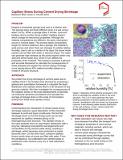| dc.description.abstract | Imagine a household sponge lying next to a kitchen sink. The sponge looks and feels different when it is wet versus when it is dry. When a sponge dries, it shrinks, curls and hardens due to suction forces (called “capillary stress”) which change its mechanical properties. Although the material compositions are different, the same mechanism occurs in cement paste. The process takes considerably longer for cement paste but, like a sponge, the material is quite porous and when there are changes to outside relative humidity, due to rain or a series of dry days, the pores inside cement can be filled with water or become empty. The water can generate high stresses as the pores expand (when very wet) and shrink (when dry), which in turn affects the properties of the material. This research proposes a general and accurate framework to calculate the consequences of these stresses and explain the cement drying shrinkage curve (drying above 40% relative humidity) based on a model of the pore structure. | en_US |
